Ruger’s Precision Rifle created quite the buzz when it was announced. As a tech guy by day, I shudder every time I hear phrases like “paradigm shift,” but to look at Ruger’s newest rifle, you’d be hard pressed to find a different phrase to describe what they’ve done.
On paper, you have a very modular platform chambered in three very competent, long range, short action cases that makes great use of an already thriving aftermarket for the AR-15. The RPR, no matter the flavor, is adjustable, modular, and functional.
And let’s not dance around the subject…it’s affordable, too. So when I got the nod to have one shipped to me, I knew I was either going to be very happy or very disappointed.
My expectations were, frankly, very high. Over the last year, I’ve had the opportunity to shoot some fine rifles at targets that were very far away. Relative to the guys on this list, I’m still learning to crawl, but I know enough to know what’s good. And on that note, it might be worthwhile to spend a bit of time discussing the topic of what makes a good precision rifle.
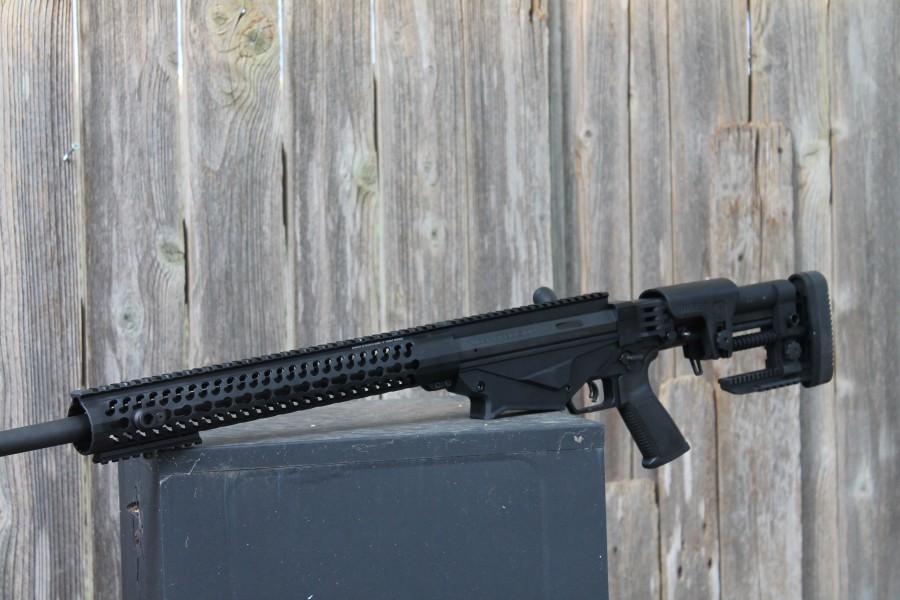
A precision rifle in my experience is what any of your non-gun friends might call a sniper rifle. The line at the this year’s Bushnell Brawl was dominated almost exclusively by bolt action guns built on the Remington 700 action blueprint. Some of them used chassis-style stocks while others used more traditional free-floated stocks with flat forends and bipods at the front and high cheek combs at the back. These stocks allow the barrel to remain untouched and also provide for stable shooting off barriers and bags. Traditionally, these rifles are chambered in some variety of a 6mm or 6.5mm caliber. The most popular ones I noticed at the Brawl were .260 Remington, 6.5 Creedmoor, 6.5 x 47 Lapua for the 6.5s and .243 WIN and 6XC for the 6s.
The most obvious characteristic that these rifles all share are the ability to put a bullet in nearly the same place, hot, cold, clean, or dirty. This level of accuracy usually comes through the usage of hand-lapped premium barrels with fairly thick contours mated to sturdy, squared receivers.
These guns are tack drivers that err on the side of heavy chambered in cartridges that efficiently deliver bullets at distances out to 1000 yards or so. What makes them so good is that they’re incredibly “shootable” rifles. Pretty much any rifle can be made to shoot well off a set of front and rear bags. But try getting that same rifle to shoot well offhand, or placed on a precarious barrier, shot from the weak side, and the story changes quite a bit. The last thing these guns share? They cost several thousand dollars.
If you read those last two paragraphs while switching back and forth to the Ruger Precision Rifle features page, you’ll notice that the RPR has a lot of these attributes. You’ll also notice that the RPR has a MSRP price of…$1399. At the time of this writing, market prices were holding fairly close to that number — not surprising given the buzz this rifle has generated. My expectation is that the market will correct as Ruger churns these out en masse. My hope is that one day we’ll see these at or below the $1K mark, but I fear that may be a bit optimistic.
So what do you get for your $1399?
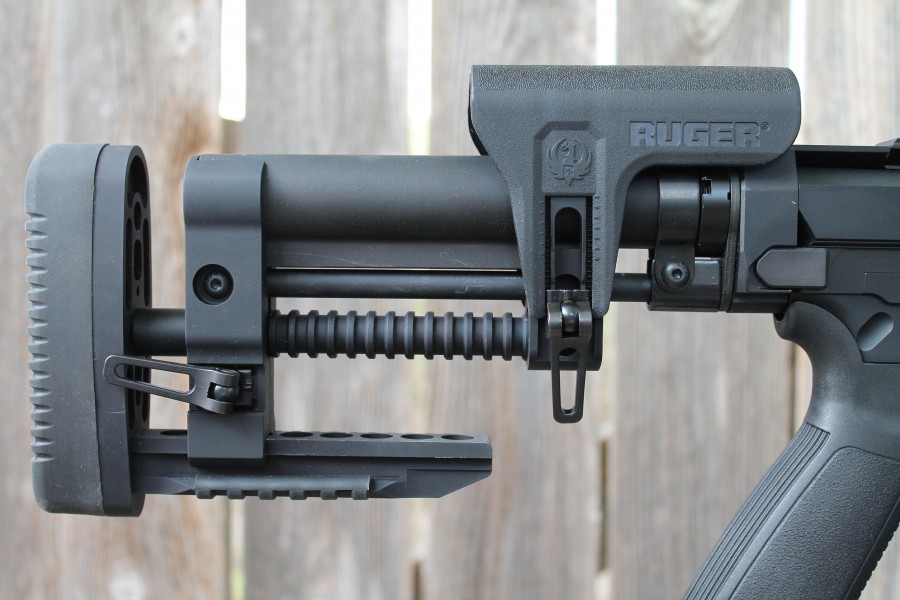
The Back Third
I’ve chosen to break up the overview into three separate pieces driven mostly by Ruger’s super-cool website and partially because there’s a lot that needs to be said about each third. And yes, the butt stock is going to get its very own section. The ass end of a rifle is arguably one of the most important parts. Most of the contact with the gun is done through the stock, and poor shooter and rifle fitment can render a mechanically accurate rifle worthless.
There are three points of contact the shooter makes with the butt stock. The first is the butt pad, the second is the cheek rest, and the third is the toe which is usually where the support hand or a sandbag are placed during prone shooting. Ruger has done a fantastic job with all three surfaces on the RPR.
The buttpad is a soft and squishy chunk of rubber that has a good deal of grip against clothing. I find that when I shoot from standing with a sling, especially on a gun with a bit of weight towards the front, I prefer a bit more grip to counteract the force of gravity pulling the rifle downward.
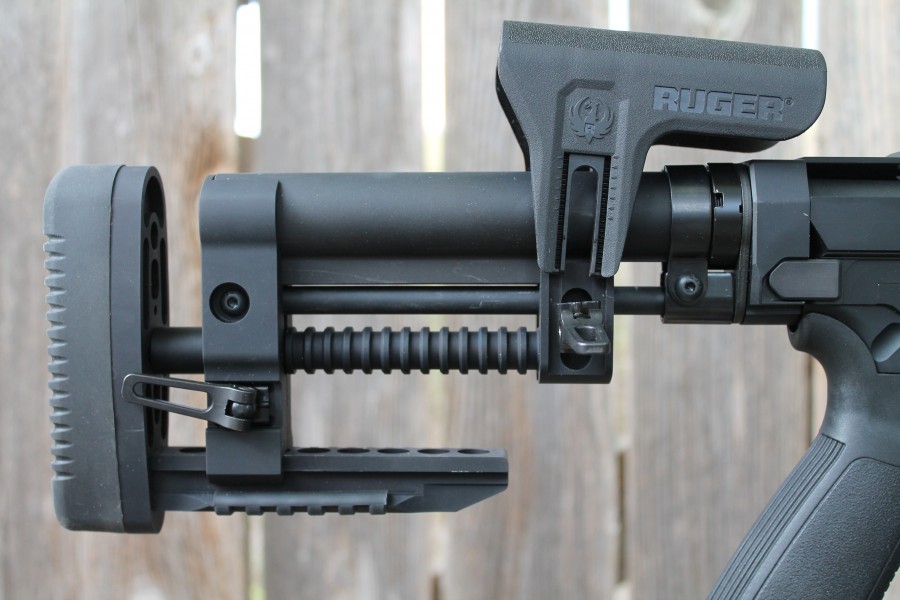
The cheek riser itself is made of plastic, but seems fairly stiff. It’s symmetrical which makes for an identical cheek weld whether shooting strong side or weak side. Conversely, a chassis like the KRG X-Ray that I used at the Bushnell Brawl is slanted one way more than the other making weak side shooting a pain.
I found the RPR’s riser shape to be fairly pleasant with only a bit of stippling to help get a good grip without being so aggressive that it yanked at my beard hairs. If I had to pick any nits, the twin tower structure that connects the riser to the stock is prone to a bit of lateral flex if you get aggressive. It’s a minor issue, but one that is not present in other stocks with adjustable cheek pieces.
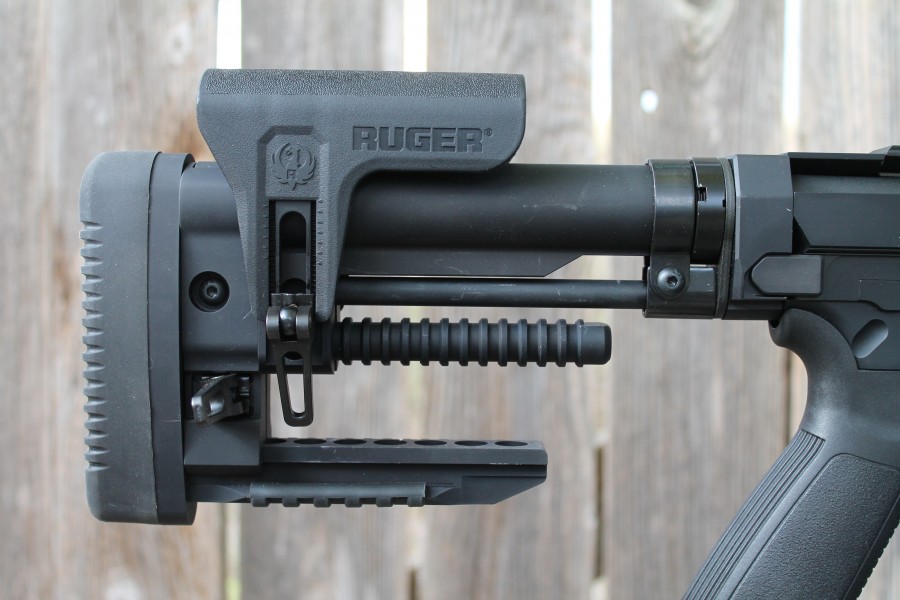
Lastly, a note on the toe of the stock. There’s a great deal of personal preference when it comes to stock shape. Some guys prefer a flat-bottomed F-Class style stock where some, myself included, prefer a slightly angular rise to the receiver (think A2 style). What Ruger did here was make the toe Picatinny compatible so users can pop in a rail-based monopod like the one from Accu-Shot. I’ve used these on a few occasions, and while I’m more comfortable with a small sand bag, I see the value and applaud Ruger for striking a fair compromise.
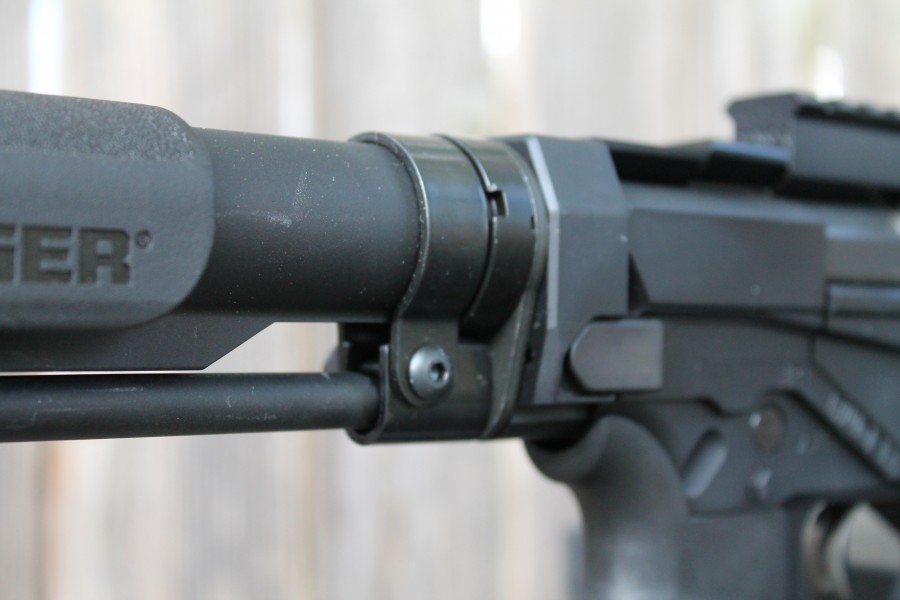
Where the butt stock falls short is in the adjustment department, or rather the confidence that things are really locked.
There are two adjustments that need attention in a butt stock. The first is length of pull (LOP) and the second is comb height. The RPR allows for a tremendous amount of adjustment in both categories, and even allows the cheek riser to be moved fore and aft, an adjustment that many high end aftermarket stocks lack. On paper, this is great for allowing for maximum adjustment for minimum dollars. I never found myself wishing for more comb height or more LOP. But getting things set was a minor pain in the butt(stock).
Ruger went with a lever-actuated quick release system similar to what you’d see on your bicycle seat post clamp. In an attempt to avoid a friction fit for those parts, the locking mechanism has teeth that mesh with identical cuts on the riser. More often than not, though, I would fail to get it locked up, and no amount of jiggling would get things settled. Once adjusted, and locked in place, things are A-OK though I didn’t feel as confident in the locking system as I do with a Magpul PRS.
Which brings up a great point. The MSR stock is built off a carbine-length buffer tube compatible with any AR-15. I’m a big fan of the Magpul PRS stock, and if Ruger threw me the keys to this rifle tomorrow, the next call I’d make would be to my brand new Texas neighbors to beg and plead for a PRS to stick on my RPR.
For a part of this test, I slapped on an A2 stock that worked just fine, save for the lack of recoil pad which made half-day shooting sessions a tad painful for my delicate shoulders. I’m curious why Ruger didn’t opt for the PRS out of the gate since they clearly don’t have a problem using third party gear on this rifle. Perhaps it was a cost issue.
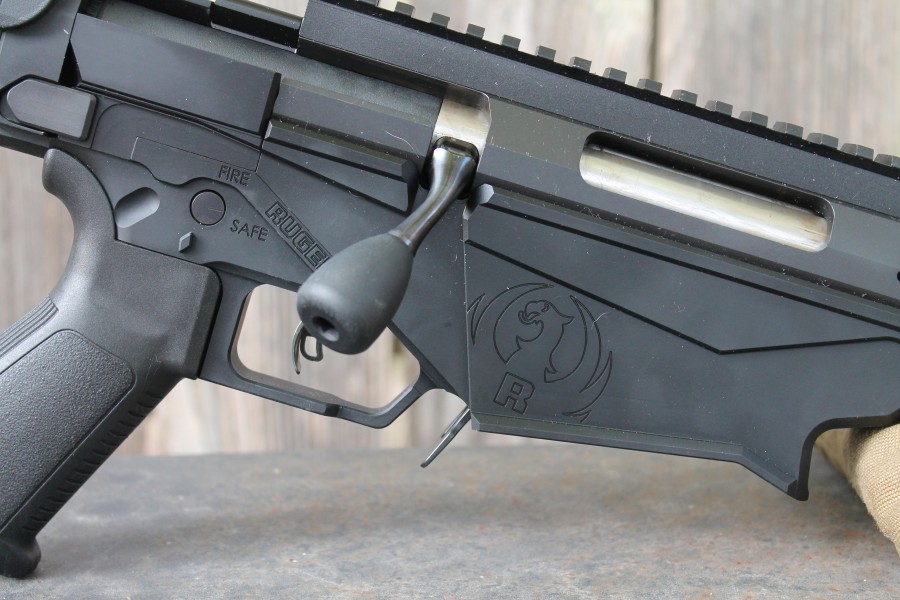
The Middle Third
If you thought I got wordy about a butt stock, just wait. The middle third being everything forward of the folding stock and aft of the barrel nut, there’s a lot that needs coverage. Probably a full 80% of the “cool” features of this rifle are contained within the few inches between those two parts. Starting with the folding butt stock, it becomes apparent that Ruger found a bunch of guys who know their stuff when it comes to shooting rifles, put them in a room, and wouldn’t let them out until they made something new and cool.
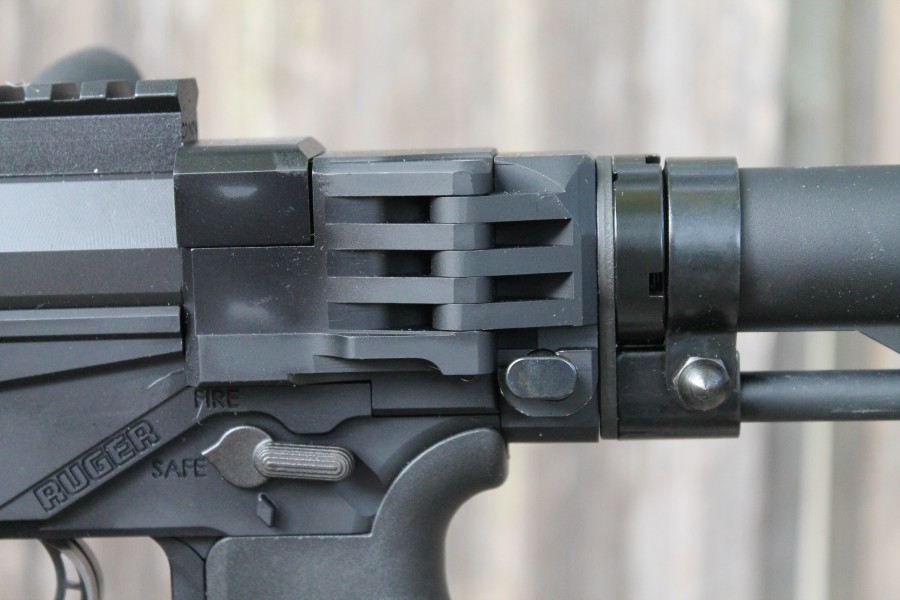
The folding mechanism is rock solid and 100% reliable. Once locked in place, there’s zero wiggle or slop. The fit is so tight that pressing the release won’t actually unlock the stock. You have to give it a bit of a love tap in the direction of travel to get it freed up. Once free, it swings to the left 180 degrees and can be locked in this position using a camming button. This is a slick little system and allows for a much more compact package for travel. Is it necessary? The answer, like most things, is it depends.
In my opinion, the typical rifle shooter doesn’t need to have a folding stock. It adds complexity and weight to the rifle. Folding stocks seem to be the purview of tacticool operators who need a minimally long rifle for transport.
The issue of course is that typical bolt guns have the back half open to the world. When you want to pull the bolt body to clean it, it’s easy as pie. Since Ruger went with an AR-15 style buffer tube attached stock, though, the options were 1) make a two-part upper and lower like the AR, or 2) do this folding stock thingy. I imagine that in the long run, this folding stock option was lower in cost and complexity.

With the stock opened up, the bolt can be removed from the action giving you unfettered acess to run a cleaning rod down the bore. You can also use this opportunity to pull the plastic cap off the back of the bolt to expose the Allen wrench needed to adjust the trigger. I was most confused by this design decision as the plastic cap seemed to be prone to popping off and rolling around on the floor of my shop. This never happened while the gun was in operation, but it seemed to be a slightly weird decision by those aforementioned smart guys.

The bolt is a three lug affair identical to the one I pulled out of the American Rifle series. Like that bolt, RPR’s has a fairly short lift and no more travel than necessary to clear a short action case from the action. I found it a little gritty until I put some grease on the relevant moving parts. With a bit of dead dino love, the bolt lift and travel was greatly enhanced. Ruger even went so far as to pre-thread the bolt handle so an end user could put an even larger knob in place of the already oversized stock model.

Above the bolt, the receiver features a 20 MOA rail that is held in place by four hex screws. The 20 MOA rail is a hallmark of most high end rifle builds as it allows the user to maximize the elevation adjustment of their scope for those truly long shots way past the 1000 yard mark. I never got the opportunity to stretch the legs of the RPR that far, but I did have plenty of elevation in case I wanted to. For this test, I used Warne’s beefy one piece mount, and had no problems mating it with the receiver.
Below the bolt handle, there’s an AR-15 compatible pistol grip that fits the hand nicely. Forward of that is Ruger’s Marksman adjustable trigger, which is easily one of the finest factory triggers on the market. Ruger says it’s adjustable from two to five pounds, but I found mine set to two and a quarter pounds from the factory and never felt the need to mess with it. Our man Jeremy is currently testing a Dvorak TriggerScan and was nice enough to put together some pretty graphs that show the travel and weight of the RPR’s trigger.
He was even nice enough to lay the RPR graph against one of the worst triggers he’s ever put on the machine, the Century Arms C308 he tested in July of 2015.
In case graphs aren’t your thing, take my word for it. This RPR trigger pull is flat out fantastic. There’s almost no takeup or grit. Jeremy’s fancy machine says .74 mm which is about 7 sheets of printer paper. It feels like less to my calibrated hand tools. The break is crispy clean and there’s minimal overtravel. I wish I had more to say, but it’s just absolutely perfect right out of the gate.
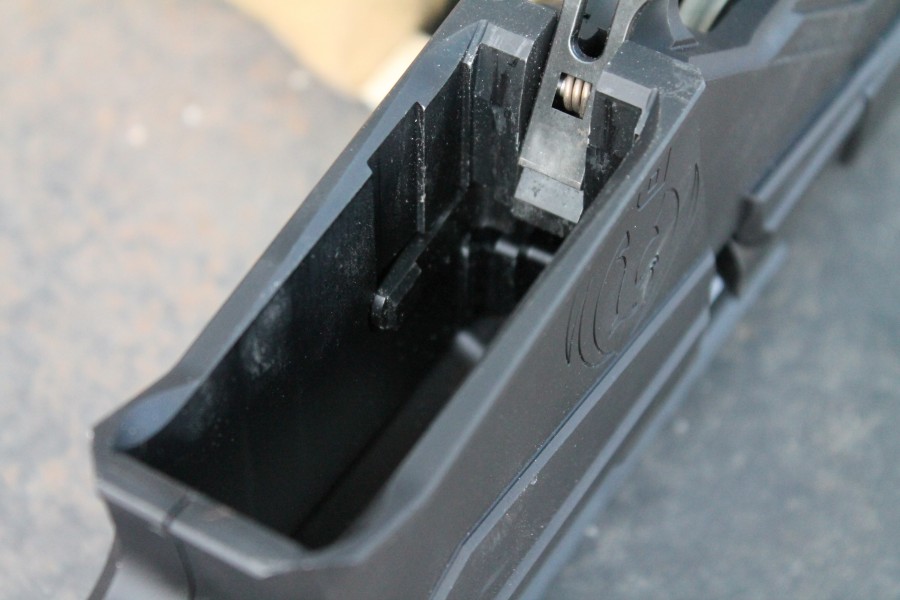
Forward of that excellent trigger is the coolest magazine well that ever existed. Hyperbole aside, making a rifle compatible with two of the most popular short-action magazines, the SR-25 style and the AICS style, is a minor engineering feat this CNC-machined piece accomplishes. Making them both feed reliably had to require the sacrifice of several large animals. I was most skeptical of this feature and did my best to make it fail, but damned if it didn’t work flawlessly every single time.
Pop a mag in, push until it clicks and start feeding rounds. Go fast or go slow, it doesn’t matter. When it comes time to drop the mag, hook your thumb along the latch at the back, push forward, and pull the mag out. Ruger sends two Magpul 10-rounders with the gun, but all the magazines I tried worked fine. This is a truly magical system and makes loading, unloading, and reloading a breeze.

The Front Third
Forward of the action is a thick barrel, covered by a free-floated Samson KeyMod rail. The rail attaches using a standard AR-15 barrel nut, but the barrel is head-spaced and attached using a proprietary nut of Ruger’s own design. After pulling the hand guard, it appears that any AR-15 style barrel nut will thread into Ruger’s barrel nut.
The possibilities are endless, though I’d be hard pressed to find a better rail than the Samson that ships with the RPR. As a KeyMod compatible rail, there’s an endless number of things to stick to the hand guard. The top side is Picatinny rail equipped which should allow you to attach all manner of lights, lasers, and steak knives and line trimmers. Ruger even ships two KeyMod pieces, a QD swivel, and a length of Picatinny with a sling swivel attachment. Those are the two most popular items people choose to stick to their guns, so Ruger seems to have decided to include those with the purchase.
The one area where I can fault the Samson rail is that it doesn’t have a flat bottom. This is really only a problem when shooting off a flat surface like a 2×4 barrier or a flat-bottomed adjustable front rest. Because of this, the rifle has a tendency to rock side-to-side, especially with a heavy scope mounted. There are a couple rails in the market that feature a squared off bottom, but the Noveske NSR and the Seekins SP3R V3 are top of mind. The issue, as you might guess, is that the aforementioned Noveske and Seekins rails are $275 and $235 respectively. The Samson Evolution has a MSRP of $199. With the number of rifles that Ruger is planning on cranking out, that cost difference adds up. Again, this is a minor nit to pick, and will probably only bother a small percentage of the target market, but it’s worth mentioning.
There are a couple rails in the market that feature a squared off bottom, but the Noveske NSR and the Seekins SP3R V3 are top of mind. The issue, as you might guess, is that the aforementioned Noveske and Seekins rails are $275 and $235 respectively. The Samson Evolution has a MSRP of $199. With the number of rifles that Ruger is planning on cranking out, that cost difference adds up. Again, this is a minor nit to pick, and will probably only bother a small percentage of the target market, but it’s worth mentioning.
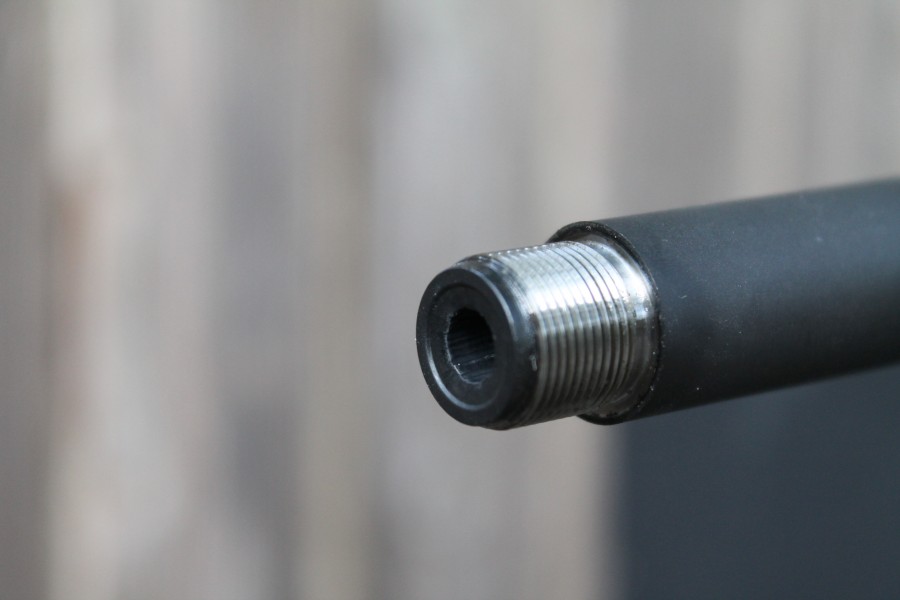
Underneath that hand guard is a hammer-forged 1:8 twist, 24-inch barrel chambered in 6.5 Creedmoor. It’s appropriately thick leading to a great deal of strength and resistance to heat-related warping. The end is threaded for 5/8″-24 and Ruger provides a thread protector which you will promptly lose after putting a muzzle brake on the end.
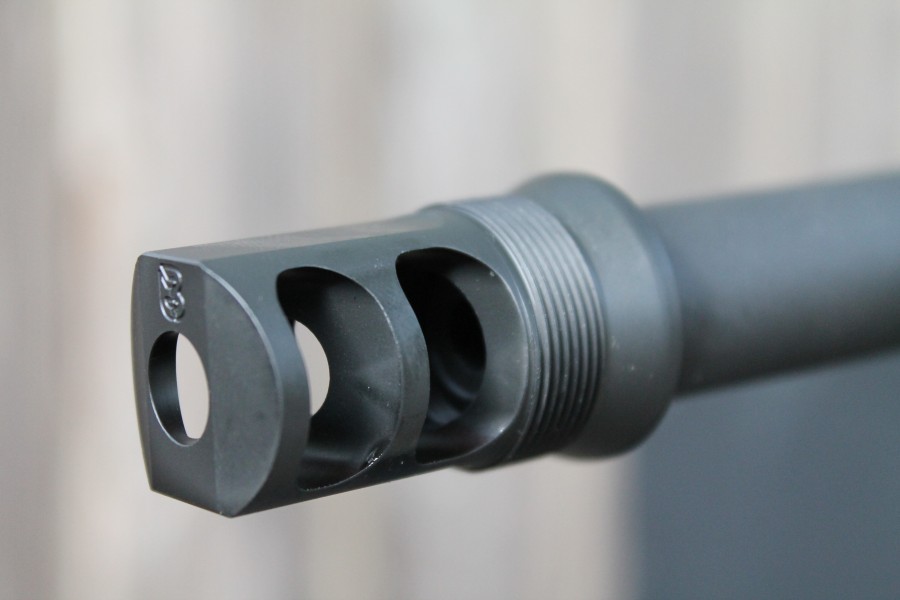
I found the barrel to be a real shooter, hot and cold, as long as it was fouled. A clean barrel would always throw a wild flier, but once given a solid five shots to foul, it would shoot the exact same point of impact, hot or cold. And believe me, I railed on this gun. The accuracy it churned out was frankly astounding given the price point.

Handling
The RPR in 6.5 Creedmoor tips the scales at nearly eleven pounds. No two ways around it, this is a heavy rifle, but then again, it needs to be. This isn’t a hunting rifle meant to be carried up and down mountains all day. It’s a precision piece of machinery meant to reach out and touch things at 1000 yards. As such, it needs a stout receiver, and a heavy barrel with a bit of length to get those slippery bullets up to speed.
Tack on another two and a half pounds of scope and mount, and you’re rocking about thirteen pounds of gun and gear. Add a loaded ten-round magazine, and you’re tipping the scales at almost fourteen and a half pounds. It can be shot offhand, but you’ll get tired of that quickly.
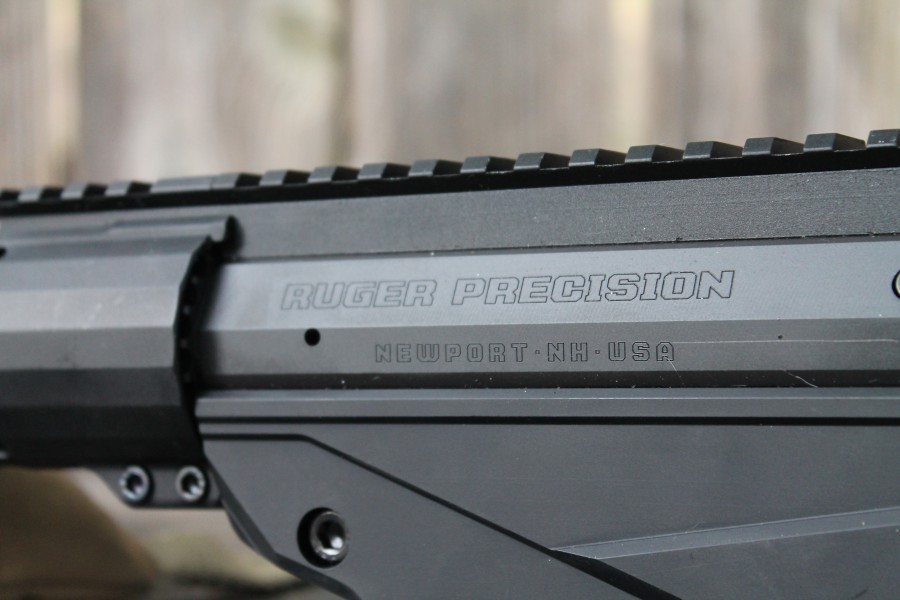
All that said, with a properly large scope and a sling attached, this is stilla very handy rifle. The barrel is a touch long, but really no longer than any other precision rifle in 6.5 anything that I’ve had the pleasure of putting my hands on. The balance point with a loaded magazine and a big scope is just a bit forward of the magazine well, but behind the hand guard. A bipod at the front moves that balance point further forward, but in either situation, the RPR is fairly well balanced. In fact, you can totally C-clamp the RPR like Chris Costa and start ripping off fast strings of fire while running the bolt like a mad man. Ask me how I know.
The balance point with a loaded magazine and a big scope is just a bit forward of the magazine well, but behind the hand guard. A bipod at the front moves that balance point further forward, but in either situation, the RPR is fairly well balanced. In fact, you can totally C-clamp the RPR like Chris Costa and start ripping off fast strings of fire while running the bolt like a mad man. Ask me how I know.

Accuracy
6.5 Creedmoor is a funky little cartridge. My sometimes pen pal Zak Smith of Thunderbeast Arms wrote an excellent article for Shotgun News in March of 2008 that gives an in depth look at the cartridge with some comparisons to other 6.5 cartridges available in the wild, notably .260 Remington and 6.5 x 47 Laupa. All three push very slippery bullets out past the 1000 yard line with very little wind drift and a great deal of retained energy.
The difference between 6.5 Creedmoor and the other two cartridges is the excellent factory support that Hornady has put behind the cartridge with factory ammo. Whether .260 REM or 6.5 x 47 are better cartridges than 6.5 Creedmoor is a debate best left to people much smarter than me, but the fact remains that the other two are “reloader’s” cartridges while 6.5 Creedmoor is very much a commercially available cartridge.
For this test, I purchased three of Hornady’s factory loads from MidwayUSA. The 120 gr. A-MAX was $1.14/round, the 129 gr. SST was $1.30/round, and the 140 gr. A-MAX was $1.19/round. To give you a relative sense of the market, at the time of this writing MidwayUSA was selling a box of 20 rounds of Federal Gold Medal Match 168 gr. .308 WIN for $1.30/round. There may certainly be lower cost match grade options for the .308, but Hornady’s offering is right in the ballpark for factory loaded match ammo.
At the 100 yard line off a very solid front and rear bag, the RPR in 6.5 Creedmoor regularly turned in ~1 MOA five shot groups with the A-MAX loadings. The groups you see above were all shot hot and dirty as I don’t personally believe in “cooking the books” when it comes to accuracy testing. Clean, cold bore shots might be a very good way to show off to your buddies what a tackdriver you’ve got, but in the world of practical accuracy, I think it’s more important to know what the gun can do when it’s hot and dirty as that is usually a situation where there’s a degradation in accuracy.
The 129 gr. SST is the fan favorite though, turning in an almost too good to be true .551 sub-MOA group. 6.5 Creedmoor has an undeserved reputation as a competition only cartridge. The accuracy displayed by the SST here proves that this rifle could absolutely serve double duty as a long-range hunting rig for those who enjoy that sort of thing.
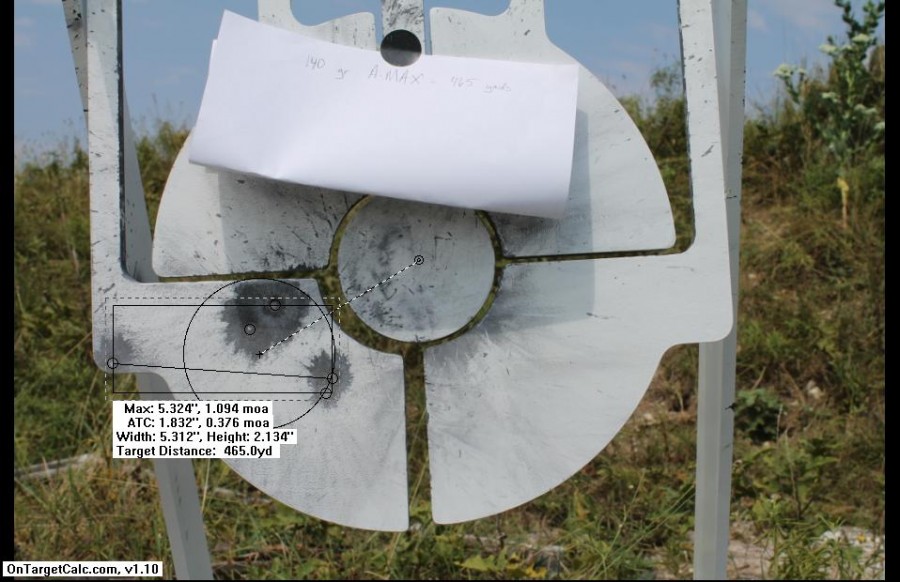
As this rifle is firmly geared at the long distance market, I felt duty bound to pack my gear, paint my targets, and drive my truck back to my favorite shaded spot at 465 yards. Under the shade of that big oak tree, I laid out my mat, set up my bags, and started plugging data into my iPhone-based ballistics calculators.
Normally, I would have a muzzle velocity to plug into the calculator, but I had managed to shoot my chronograph that morning, so I looked up the values from my Ruger American test for the same cartridge and plugged those in instead. Unfortunately, I didn’t have any data for the 129 gr SST so I took a slightly educated wild ass guess (SEWAG) based off the muzzle velocity printed on the back of the box and went to work.
The reason you only see two targets is because my SEWAG for the 129 gr. muzzle velocity was off a bit which resulted in my shots landing high on a 10 inch plate. Two of them skimmed the top while three impacted on the top edge. I still feel that the 129 gr. SST is the load this gun likes best, but I was out of ammo and under a deadline so the actual results for that ammo are a mystery.
The 120 gr. and 140 gr. A-MAX did register hits and I was able to plug them into OnTarget. The results are quite favorable as you can see. The 120 gr. A-Max, the more accurate of the two at 100 yards, maintained its edge out past a quarter mile giving a .952 MOA group. The 140 gr. A-MAX still did quite well showing a 1.094 MOA group. As you can see, my wind reading was spot on for the 120 gr. and just a touch aggressive for the 140 gr.
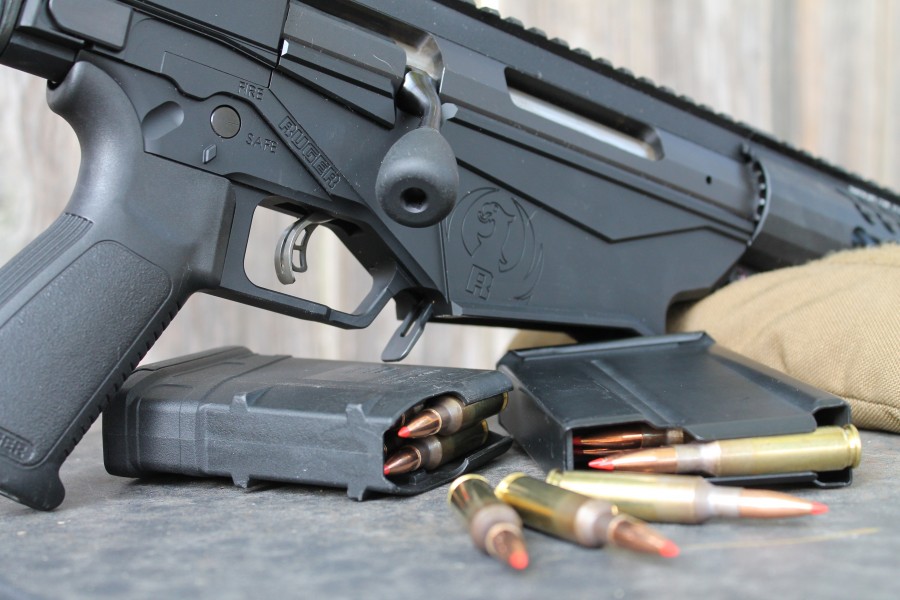
Conclusion
As I said at the start of this review, working in technology has made me absolutely loathe business buzzwords. As much as I shudder to write this, the Ruger’s Precision Rifle represents a paradigm shift in the market for precision rifles. Assuming you were convinced that a 6.5 caliber rifle in a short action cartridge set up for competitive long range shooting was what you needed, your factory options were somewhat limited.
Very few of those offerings have detachable magazines, and the ones that do are proprietary in nature. To my knowledge, not a single one includes a 20 MOA rail from the factory. Some of them don’t have threaded barrels. None of them have threaded bolt handles. So if you wanted a rifle that has all those things, you could either buy one of those factory rifles and start hacking it up or you could troll the secondary market and pick up a Remington 700 action that you could send off for a new barrel, trigger, bottom metal, 20 MOA rail, oversize bolt knob, and bedded stock or chassis. All of that will cost you several thousand dollars. I generally figure that a sorted, accurate precision rifle will start in the $2500 neighborhood and go up from there.
The RPR’s MSRP is $1399. Mount a nice scope, throw a bipod and a sling on it, and start shooting. If you end up hating it, swap out the stock with any of the widely available commercial offerings for the AR-15 and go to town. Same thing for the hand guard. Even with both of those upgrades, you’re still under two grand. About the time you burn up the factory barrel, somebody will be making high quality replacements that you’ll likely be able to install at home with the bare essentials in tools.
Ruger has absolutely knocked it out of the park with this long-range rifle giving you fantastic out-of-the-box performance. It’s a great gun to shoot accurately from a bench, but does equally well off improvised barriers, rests, and bipods. After the shoot, this bolt-action rifle offers easy disassembly and care. It represents one of the best values in the market today, and I look forward to seeing where things go over the next year.
Specifications: Ruger Precision Rifle
- Caliber: 6.5 Creedmoor (also chambered in 6mm Creedmoor, 308 Winchester, 6.5 PRC, .300 Winchester Magnum, 300 PRC, and .338 Lapua Magnum)
- Capacity: 10 rounds (20 and 25 round PMags are available in the market)
- Stock: Folding, Adjustable Length of Pull and Comb Height
- Barrel: Cold Hammer-Forged, 5R Rifling, Chrome-Moly Steel, medium contour
- Twist: 1:8”
- Barrel Length: 24.00”
- Overall Length: 42.25” – 45.75”
- Folded Length: 34.60”
- Height: 7.30”
- Width: 3.30”
- Advertised Weight: 10.60 lbs.
- Measured Weight: 10.824 lbs
- Length of Pull: 12.00”- 15.50”
- Trigger: Ruger Marksman Adjustable
- Suggested Retail: $1,399 (about a hundred bucks less via Brownells, also available via Cabela’s)
[buy_now link=https://bit.ly/37QScrH”]
Ratings (out of five stars):
Fit, Finish, Build Quality * * * *
The Ruger American Rifle I tested a few months prior was rough in every way shape and form. The RPR seems to have been built of similar parts with a much higher degree of final finish. There’s none of the rough machining evident in the American series, and the fit and finish is really top notch. The only exception is the butt stock and I’d rate that 90% of the way to being perfect.
Customization * * * * *
If I didn’t think it would break Nick’s review engine, I’d award the RPR six stars for customization. Every single part of this gun is modular from the stock all the way to the barrel. There’s not a single thing except for the receiver and bolt that a person with a minimum of tools couldn’t swap out. This level of customization is only going to get better as this rifle gains market traction.
Accuracy * * * * *
No matter how hard I tried to skew the results toward the worst end of the spectrum, the RPR kept cranking out ~1 MOA five shot groups at 100 yards. I got the barrel so hot it melted my glove before I shot the 100 yard and 465 yard groups you see above. That’s rough on a rifle and the RPR shined through. I have no doubt that getting a gunsmith to fit a high quality aftermarket barrel to this gun would make it better across the board and likely sub-moa, but for the price point, it’s first rate.
Overall * * * *
I had a really hard time giving this rifle only four stars, but I ultimately felt that the butt stock held it back just enough to warrant a less than perfect score. I also think that’s indicative of just how good this rifle is. When the one thing that you have to bitch about is the stock and how it’s just a little flimsy, you know that, a) you’re reaching a bit, and b) the rifle is nearly perfect. And for the price, you will not be disappointed.

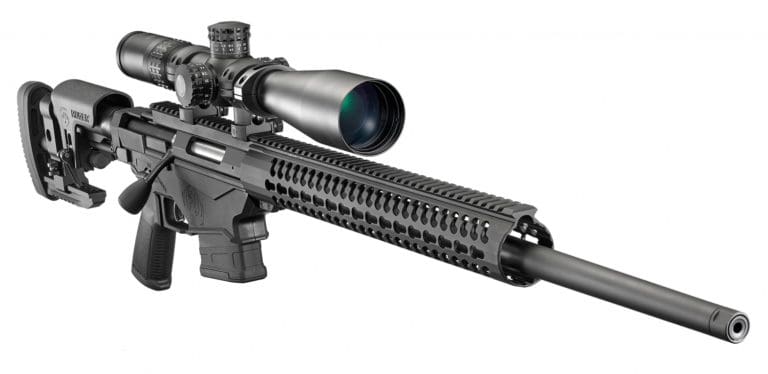
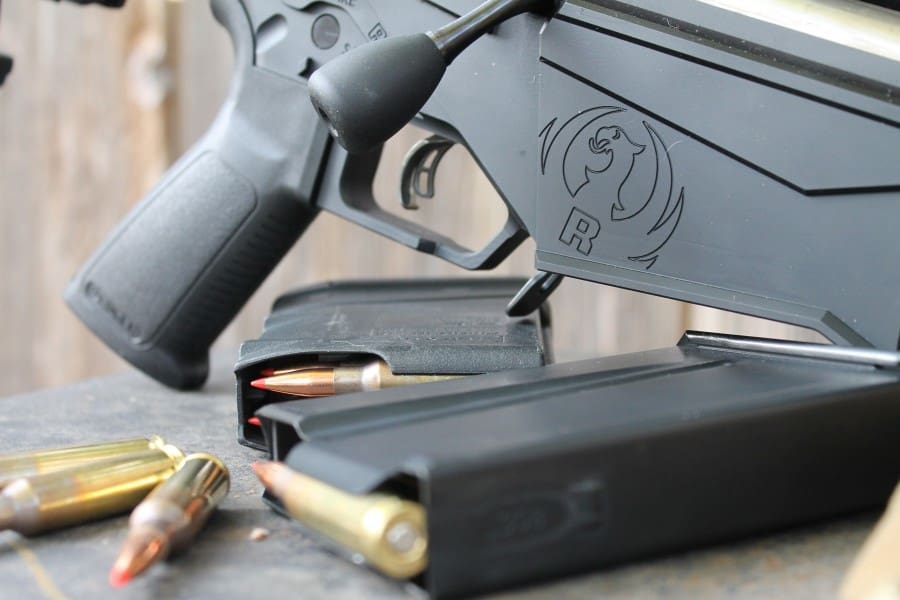

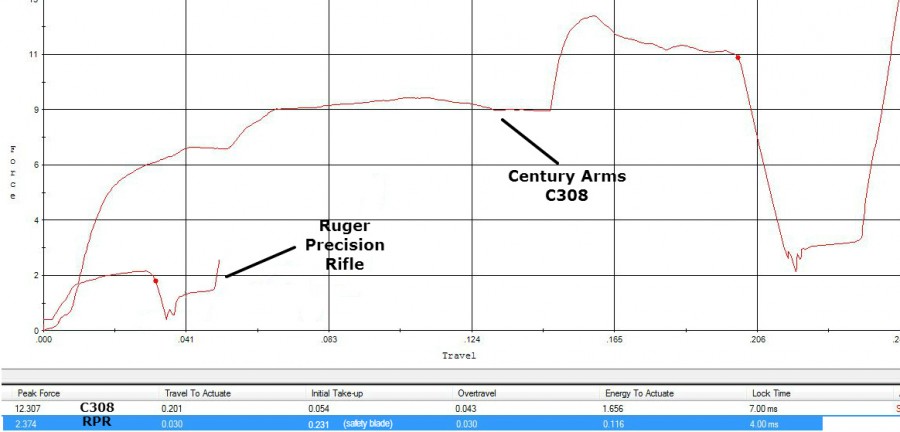
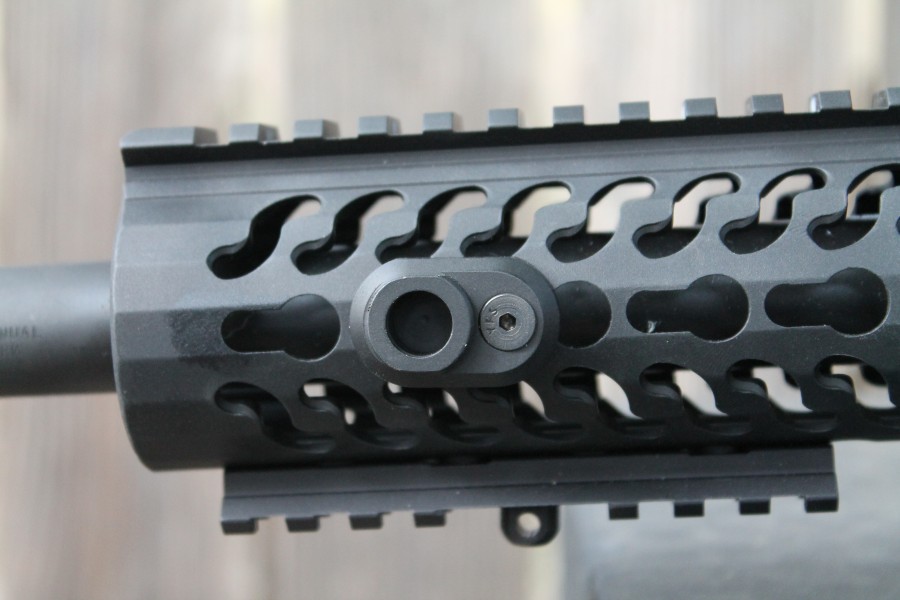
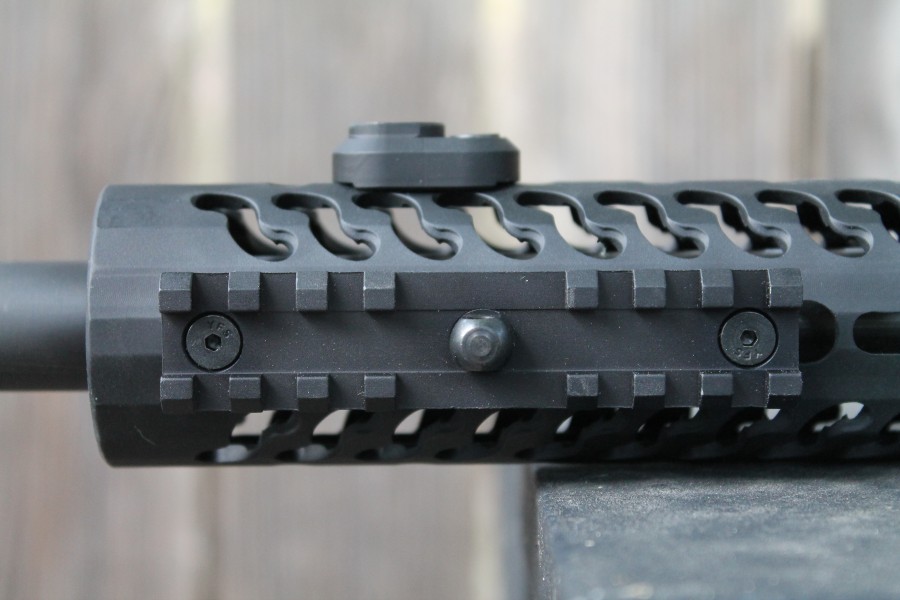
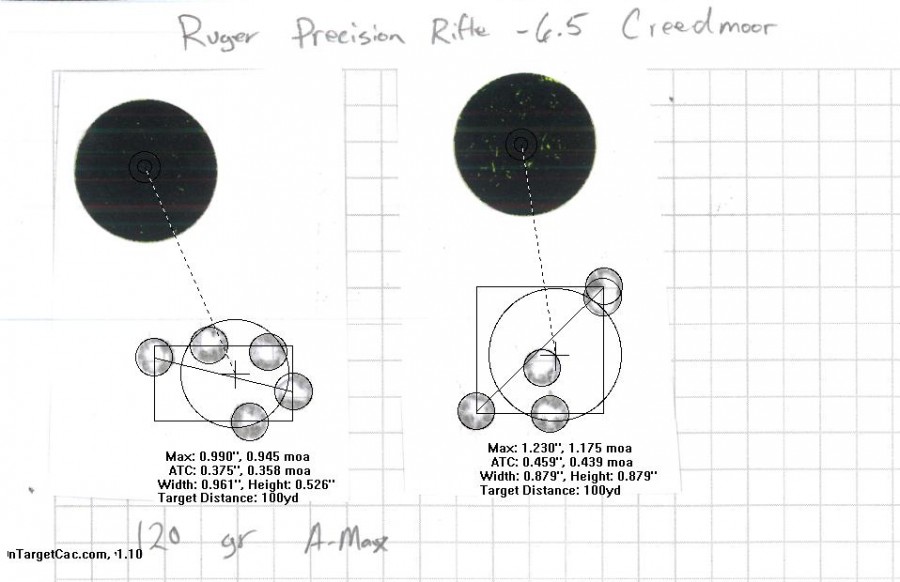
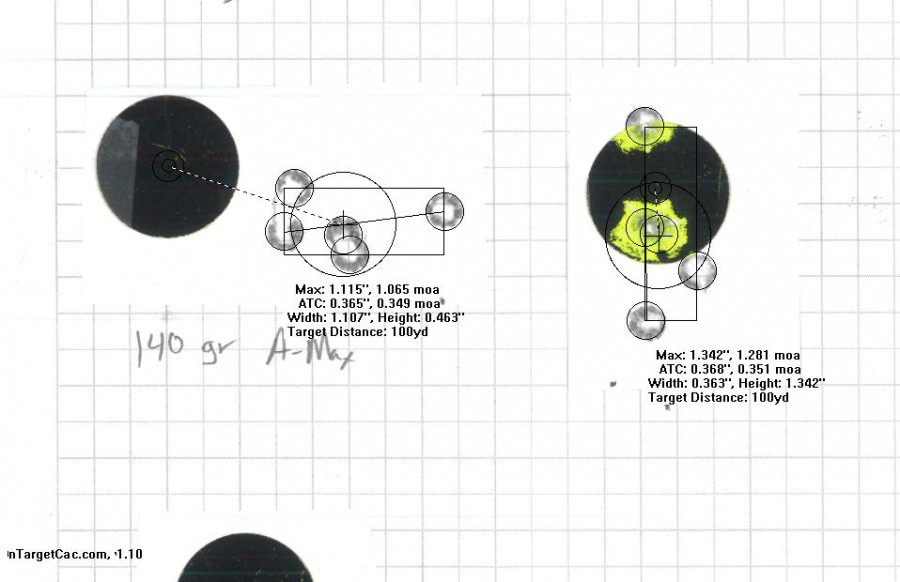
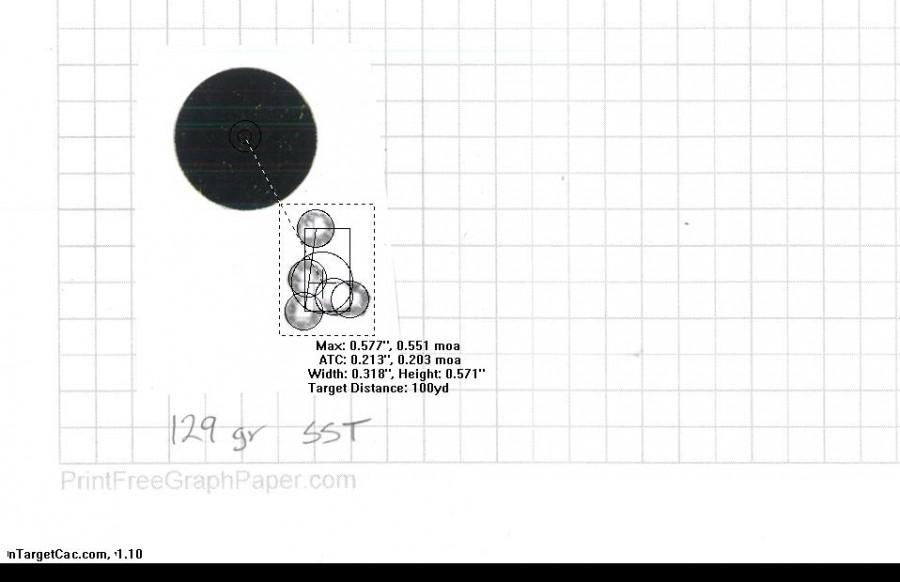
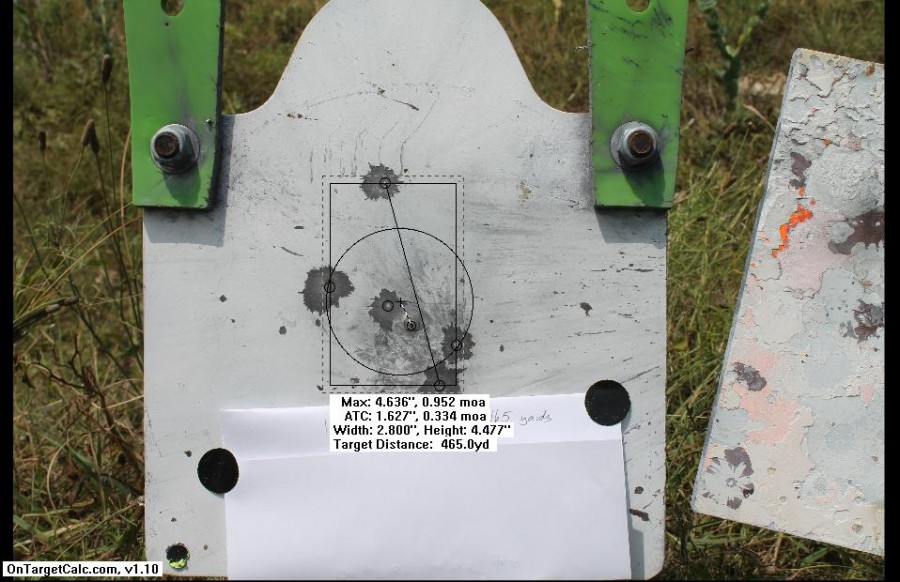



There is a fantastic thread going on these at the snipers hide forum. Lots of people have picked this rifle up for $1k, some even a little less but it appears that the demand is starting drive prices higher as time goes on.
Would you mind posting the link to that thread?
http://www.scout.com/military/snipers-hide/forums/5514-bolt-action-rifles/13955138-new-ruger-precison-bolt-action-rifle
Also, a few guys have already switched the stock for the PRS.
Great review. I am still curious why they don’t offer the 308 in longer barrel configs.
Huh? Why? With a 20″ barrel shooting Fed GMM 175gr you barely lose velocity over a 24″ barrel. I don’t get the obsession with long barrels being “better” has that not been sufficiently debunked yet?
Look I say this as someone who regularly humps around a 12lbs remington 26″ sendero contour 308, and yeah, if you play with powders and bullets weights you can sort of hot rod a 308, but why? There are way too many short action cartridges that will kick the crap out of the 308 past 800yd line.
Ok so you have found reloder 17 and are one of the few people who actually extract reasonable down range accuracy out of 208amax or 210bergers (I am twist limited to 185gr Bergers) you get the same or better performance from factory loaded 140gr 6.5Creed ammo. People get stars in their eyes looking at the velocity some guys are putting down with Re17 and some of the heavier bullets from 308, but no one likes to mention how temperamental slow burning powders like re17 are out of a small case like 308. So yeah with a long stick you can do cool stuff with a 308, but you can equal or better it with factory 6.5 offerings with way less recoil.
Fully agree. You’ll just never get close to what the 6.5’s and 7’s will do with modern VLD bullets in a .30-cal anything until you’re pushing bullets over 210 grains.
And out of a .308, that means you’ll be seating deep and pushing some pressure.
I own rifles chambered in 6.5Creemore, in 7mm08, and in 338Federal. But no .308s. A friend of mine who builds stocks gave me a very nice stock made to fit a short action 700. I figured I would finally build a .308. In the end, nope, built another 7mm08.
I’ll agree with you on that 6.5 CM. It is sweet. “WICKED” is a good word for it Kevin. Everything I’ve reloaded… whether above or below max charge (Hornady or Hodgdon manual ) the groups are as good or better than Hornady 140gn. factory ammo and every time I finish at the range I go home with a smile…great buy at under a thousand. I own an AR10- 308, a Marlin 308 Leveraction and if I had purchased the Ruger before, I wouldn’t have the 308’s but more 6.5’s.
Agreed. My LTR .308 is a 20″ barrel for those reasons. Sure, I could get another 75-100 FPS or so from a 24-26″ barrel with target / match / hunting bullets, but I don’t see the point. If more velocity is desired, 300 WSM / .300 WM, etc. are the way to go.
The .308 doesn’t smoke up targets when strung out to “max” velocity anyways. My best groups are currently with Eagle Eye 175 grain bullets at an average velocity of about 2620 FPS from a 20″ barrel (from an un-shot chronograph!). That’s about .6 MOA, but those were admittedly with 3 round groups.
Regardless, the .308 isn’t a very good round for 800 yards plus. Too bad the USMC didn’t get that memo. They’re going to soldier on with modded Vietnam-era Remington .308s for the foreseeable future.
Interesting, my results with eagle eye were decidedly “meh”. My first 5 shots from a clean bore got about 5 MOA (yes five!) of vertical stringing. It eventually settled down and printed some barely half MOA groups but threw some unexplained vertical flyers. 14 out of 20 had cratered primers and one actually yielded a sticky bolt lift.
Judging by the recoil from a 12lbs rifle and the cratered primers, it is toasty for sure.
It is a rare thing indeed when the most accurate load is the hottest load.
If one looks through a Lyman reloading manual, one sees this trend, since Lyman calls out both max loads and accuracy loads in their tables for most cartridges.
DG, it is rare, but in one case I’ve seen it happen regularly. In my 3.338WMs, for both my 70 and my 700, the most accurate load is also the fastest load. In the 24″ 700 it’s a 250gr Berger pushed until the bolt gets sticky, and the same for the 22″ 70 but with a 210gr Barnes.
Is that common in the magnum calibers?
No, it isn’t, and especially not in the .338 WM.
the problem is not speed, is stability, 20 “does not stabilize 308 (20” -2.8 “Cartridge dimensions = 17” real barrel)
I have a RPR 6.5. About 2,500 rounds through it. I found 130 gr bullets are most accurate. Benchrest bipod free rear. Under 1 moa any distance using Kester elite. It does not seem to make any difference whether I use Berger match grade or Hornady match grade or Hornady whitetail or Seller and Beloit as long as it is close to 130 gr. Heavier bullets are less accurate regardless who makes them. After 2,500 rounds the accuracy has not suffered. I shoot slowly and take it easy on the barrel. I hope to get as much as 6,000 rounds through it
Because the Ruger PR(s?) is competing in price with the 30″ barreled Savage Model 12 FTR and the 26″ 700P. Given that FTR is one of the most popular and fastest growing shooting sports and requires .308 Win to be pushed to 1k-1.2k yards, there is real demand for an off-the-shelf rifle at this price point with a 26-30″ barrel.
The Savage FTR and 700P are enormously popular, and while they are both far more accurate than this Ruger seems to be for the same money, they are missing a good stock and the cheek riser out of the box (though with the 700P. there is enough money left over for a budget McMillan/aftermarket riser combo). It would seem that this Ruger with a bit of tuning could have addressed the issues of the Savage/700P if it had a longer barrel.
the problem is not speed, is stability, 20 “does not stabilize 308 (20” -2.8 “Cartridge dimensions = 17” real barrel)
Great review! How do you shoot a chronograph? I know it is accomplished regularly (my local range lost two in a few months and gave up), but I can’t figure how. I used it once, and your accuracy should have to get down to around 1000 MOA before you hit any part. ‘Fess up.
I’ve done it. I went out to get .223 velocities from only like 10 feet off the muzzle and it was a little overcast so I knew the bullet would have to pass fairly close to the lenses to register. I managed to forget that the scope was 4+ inches over the bore and at only 10 feet away it wasn’t a good idea to aim like 3 inches over the lenses and pull the trigger.
It’s one of the many advantages to the MagnetoSpeed system. Much harder to accidently shoot haha
Next time shooting over a Chrono mark an aiming point on the target, then shoot with the crosshairs on the aiming point and set the chrono below the hole. Just an idea.
Funny, I’ve never shot my chronograph when putting over 1000 rounds through it, but as soon as I let a young man I met at the range chrono his AR, one of the sunshades was dismembered.
Look, regardless of HOW you do it, there are still only 2 types of people in the world.
Those who have shot their chrony, and those who will.
Actually, there are two kinds of people in this world: those who divide the people of the world into two kinds, and those who don’t.
Actually, there are THREE kinds of people in this world: those who can count, and those who can’t.
Jeremy, actually there are 10 kinds of people in the world: those who think in binary, and those who don’t. 😉
Too many people use the “well, the scope view is clear, so let’s light one off!” method of shooting through a chrony.
The proper method is to pull the bolt, look down the bore, get the boreline to go through the middle of the chrony, then look where your scope is pointed on the target.
Or you could take measurements of how high the scope is off the boreline and do a little reckoning, but these days most people seem to be allergic to even that modest bit of mathematics.
When chronographing a rifle, I put one of my sight in targets (a series of concentric rings on a 1″ grid) right next to the chronograph and tape a second target to the chronograph’s back rabbit ears.
I target the center of the rings on the first target in the scope (or optic, irons, etc.) and fire. I then see where the bullet hits the target to determine my sight offset at that range. From that, I extrapolate where to aim on the second target to get just a few inches above the sensors.
So far, so good. Now if I could only remember to take my tripod with me every time.
“Great review! How do you shoot a chronograph? I know it is accomplished regularly (my local range lost two in a few months and gave up),”
If your range required a cash deposit when members borrow the chrono they will live much longer…
🙂
When I got the e-mail from Ruger that these were coming out, I got excited. Looks like a great rig for distance shooting, and all the reviews sound extremely positive. And you can’t beat that price with a stick. This makes more sense to me than an AR-10 for distance shooting at this price point.
“I’m curious why Ruger didn’t opt for the PRS out of the gate since they clearly don’t have a problem using third party gear on this rifle. Perhaps it was a cost issue.
Ya think? Those Ruger guys must have been sweating every nickel to keep the price low, and I bet using their own buttstock was a huge cost saver. It’s also a very “personal” part of the rifle – so they knew that no matter what they included, some folks would change it out anyway. So it’s a good place to save money which could be allocated to the barrel or other parts less likely to be user-replaced.
The article has an error.. the writer keeps calling it a heavy barrel, but not only is it not a heavy contour, Ruger’s own literature calls it medium contour. It’s arguably the one weak spot of the rifle – you’d think you’d want a heavier barrel on a precision rifle, especially when you’re already at almost 11lbs.
Well, most people here at TTAG are used to the thin, wispy barrels that are on AR’s and AR-like rifles. Most here have never seen a long-range competition barrel – eg, a F-class rifle, with a barrel blank that has been barely turned down from the 1.250+ diameter to polish it up a bit, at 28 to 30″ long.
One of my AR’s has a 18″ barrel that’s 0.750″ at the muzzle, and 0.875″ behind the gas block. The look on people’s faces when I hand them that rifle are priceless.
Now that’s my kind of AR barrel, I’d love to shoot something like that-and then build one with that contour. Was this a blank you rifled yourself, or was it an off the shelf barrel you fitted to the upper?
It’s called an SPR profile and most major AR barrel manufacturers make them. No need to “build” anything special. I am partial to Wilson Combat for AR barrels, just put an 18″ rifle length SPR barrel from them on a rifle I assembled for my dad, prints right at 1 MOA with a gritty mil spec trigger and Barnes Vor-tx 55gr ammo.
Excellent, thank you for the tip on both the barrel and ammo.
I made it from a blank. It’s polished 4xx stainless steel. Oh, and it has a 11 degree target crown, no flash hider or compensator. It’s heavy enough that the recoil is about that of a BB gun. Made my own gas block out of a piece of scrap aluminum.
That’s the other reason why people gawk at it. No bead-blast finish or black phosphate need apply on my guns. 😉
While it is close to a SPR profile, mine is a tad thicker. Most SPR’s are 0.730 at the muzzle, 0.840 behind the gas block, and have a 1/2×28 muzzle threading on them. Mine’s thicker and has no threading for a comp/suppressor.
Ah, the allure of stainless steel. That sounds like quite the visually appealing setup.
I run an AR with a 20″ barrel that’s close to that thickness. I love it. No recoil and very little POI change as it heats and cools. It’s target crowned, shiny, and fluted.
Waiting for a .270/.308/.300WM version…
You’ll likely never see this in a long action, so no .270, no .30-06 and no .300 WM.
And in an accuracy rifle, you’d never see .270 Win anyway – there are very few modern long range bullets made for .270’s.
You are probably right. I would have liked to see this in .280AI.
They already offer a .308 and .243
Other than the end cap are there any other plastic parts in the bolt? I heard some talk at my local range about a guy who had one of these and the bolt failed. The failure was due to plastic parts. I dismissed it as rumor but have a chance to ask someone with hands on time with the rifle.
EGW makes/made a flat bag rider that slides on 1913 rail. 3″ wide, 4″ long .
That contour is very much on the thin side for PRS style shooting.
Most of the precision rifle guys In our club favor a medium to heavy Palma contour, and I’ve got an mtu 260 barrel to avoid poi shift during high volume, fast strings of fire.
That being said, my friend did a fast 10 round group and didn’t notice his RPR walking at the end of it.
Agree with the review, but I’d give it a final rating of 4.5 or 5 stars. It outperforms everything in the same price range that I’m aware of.
On a somewhat related note, I’d love to see Ruger scale this up to 7mm Mag / 300 WM / .338 Lapua and put a Magpul PRS stock on it. That would somewhat describe the Savage 110 BA – also a great gun for the price.
If I got one I’d be heavily inclined to put a PRS on the back end and a 416R stainless barrel on the front.
Thanks for the write up.
People who want a .338 Lapua usually haven’t priced one, nor shot one.
If you want a .338 Lapua you’ll shoot frequently, you’ll need to think about a rifle that comes in at 15 to 20lbs, an extra-long length action (longer than magnum length actions) and so on. The .338 Lapua is an expensive proposition all the way ’round.
There are cheaper and better ways to get to 1000 yards that will abuse you and your wallet far less. A .375 Ruger with some of the new VLD pills might be a better way to go…
I already have a Savage 110 BA .338 with a Bushnell ERS 3.5-21 on a La Rue LT 111 mount. Looks like this Ruger is a pretty good way to get out to 1000+ in the 6.5 flavor. I still want a 7mm Mag or WSM, but they probably aren’t going to make it. A Ruger Precision Rifke scaled up to .338 Lapua could certainly be a good competitor to the Savage 110 BA platform. American Eagle makes a “reasonably priced” 250 grain .338 Lapua load. So does Herter’s / Sellior &Bellot.
I’ve gotten rid of my .338LMs because my .338WM did all I needed it to do, with the exact same bullet, at only about 100fps loss at the most, and so much cheaper. I know there are a whole lot of smarter shooters out there than me, so what am I missing here? Why aren’t more people shooting the WM instead of the LM?
I’m thinking the .338 Lapua does a fair amount better in pushing 300 grain bullets than the .338 Win Mag. I’m not sure regarding load data (I’m 2,000 miles away from my reloading stuff and don’t own a .338 WM), but the 300 grain bullets obviously have much better ballistic coefficients than the 250 grain bullets. A hot loaded .338 WM with 225 or 250 grain billets is “pretty close” to a .338 Lapua.
A warm .338 Lapua load can push a 300 grain bullet to around 2850 FPS from a 26-27″ barrel. I doubt a .338 WM has the powder capacity for that.
Wikipedia has the .338 Lapua at 114 grains of case capacity and the .338 Win Mag at 86. Dyspeptic shared some of his hot .338 WM loads and they were impressive.
Accur81, at the 300gr weights you are dead on. The WM can’t match it. I’m a solid 150fps slower than that, albeit with a slightly shorter barrel. At the 250gr weight I just don’t see enough difference for anything I can realistically shoot.
As I recall, I only called out some of my 210gr and 250gr loads. My 210gr load is pushing about 3,000 fps at the muzzle, which is only about 100fps hotter than factory. It holds a 2″ group and under, maybe less if I tune the BOSS brake really carefully.
The .338 Lapua completely owns the .338 WinMag in velocity. But the point of the Lapua is to push a 250 to 300gr pill, not a 180 to 250gr pill, which was the design point of the .338 WM.
This is yet another ugly rifle that has all the charm of a cheap lawnmower muffler. People are actually forking over that kind of money for it? Yuck.
Yea, I agree.
But we’re two of what appears to be a small minority of ‘gun snobs’ who would rather be caught by our wives with a cheap floozy than an ugly rifle…
She’s not a ‘floozy’.
She’s ‘friendly’. 🙂
#FloozyLoveLivesMatter
Samson, not Sampson.
Completely my fault. And now fixed.
Grrrrrr.
When the RPR was announced last month, I immediately contacted GT Distributors. They hadn’t heard of it and didn’t even have a parts code for it, but after I provided the part number to them they ordered a 6.5 CM for me at the insanely low price of $899 (prepaid special order), and indicated that per Ruger it would take about 2 weeks to come in.
That was almost six weeks ago.
Latest word from GT (this morning) is that their first shipment of RPR’s is due to come in this week, but Ruger has released exactly *one* in 6.5 CM to them — and someone managed to get ahead of me on the list for it.
With all the rave reviews the RPR is getting, I have a feeling I’m going to have a long wait . . . .
Hmmm, doesn’t appear to be enough shoulder for a direct thread suppressor. I’ll have to see one in person, before ordering one. Still a great review, Tyler.
1. .260 Rem and 6.5×47 both have available factory ammo, the 6.5×47 uses Lapua Scenar pills, which are very high Bc pills.
2. A scope that you would use at 600+ yards for precision shooting will set you back over $1K, and perhaps as high as $2K.
Like competition precision at paper? Because I know snipers used to kill people all day long at crazy ranges with 4x and 6x and 10x fixed scopes. In fact they still do. Some 1st world countries still don’t go past 6x. That doesn’t mean they still use cheap scopes though. A skilled marksman will have no problem making hits on man size targets out to 1200 meters with 10x scopes under 1k.
“A skilled marksman will have no problem making hits on man size targets out to 1200 meters with 10x scopes under 1k.”
I’ll completely agree with your magnification argument. 10X is plenty. But not your cost, unless you are considering shooting only in full light, without glare, and without the level or durability in many modern scopes. With those factors, which I would consider required of a “battle scope”, I don’t know where you are going to get a ranged reticle quality scope for less than a grand without some kind of sweetheart/friend deal.
Nobody has “no problem” making accurate “man sized” shots at 1200 meters. I’ve met, shot with, and known some of the better military shooters in the world, and all of them would take any 1,000 meter+ shot seriously. Can they do it consistently? Yes, but it’s not an easy task for anyone.
JWT addresses your shooting at man-sized targets issue.
Since not many people get to take legit, sanctioned shots at man-sized targets at 1,000 yards, yes, I meant on paper. F-class competition, specifically.
If you look at the typical scope used by a F-class competitor, you’re looking at something on the order of a 12-42X56mm or 15-55×52 Nightforce scope. Price? About twice what this rifle costs.
When I give you the cartridges, barrel makers, barrel lengths, profiles, stocks, optics, sight pictures, etc used to make 1,000 yard shots, I’m talking of the equipment I see actual shooters who shoot competitively using. Not apocryphal shooters, but guys I know who compete, for real, at 600 to 1,000 yards. Many of these guys have been able to get into shooting at range with cheaper rifles (Savages in 6.5×284 in particular) and I expect some people will be able to start in F-class with this Ruger rifle in 6.5 Creedmoor, but there’s very little way to get around the optical issue. Nightforce scopes, high-end spotting scope (that cost from $1200 up to $2K themselves), lovingly handcrafted ammo, usually using Berger bullets, powders that give low SD’s on MV. The results speak fo themselves – out of 15 shots, 12X’s, out of 20 shots, 15X’s, and so on. The best group sizes at 1,000 yards (usually seen in the benchrest competitions) are now under 2.0 inches.
When you’re trying to throw down groups for a score at 1,000 yards, you need to see the target well and clearly in order to resolve exactly where you’re laying the crosshairs. You have to contend with mirage, haze, etc. It is possible to shoot F-class with aperture sights, and people have done it, but you’re still going to need a spotting scope to see how you’re doing in the wind, and a serious spotting scope for long range shooting will set you back $1500 to over $2K.
Serious shooting at 1,000 yards costs money. Bring lots of it.
Just checked and copied this from the Ruger website. It is available in .308.
Purpose-built to distance itself from the typical long-range rifle.
The Ruger Precision Rifle™ is a highly configurable, in-line recoil path, bolt-action rifle. Available in .308 Win., 6.5 Creedmoor and .243 Win., the Ruger Precision Rifle™ offers outstanding accuracy and long-range capability. But don’t take our word for it… hear it from the experts.
I’ve been dying for this review. And watching gunbroker and hunting all over to buy one.
I finally gave up and have started to just build one.
Grrr.
Actually building 2. One bolt and one autoloader.
So far, the ruger seems to be made of Unobtanium.
Look at building an Eliseo tube gun on a 700 action instead. You’ll be happier with the results, I think.
What a completed tube gun looks like:
http://www.pierceengineeringltd.com/category/tube-guns/rifle/tube-guns
Source for chassis systems:
http://www.gotxring.com
I’m thinking an 18-20″ stainless barrel in 6.5 CM over a solid “billet” AR-10 lower and a good 2-stage trigger would make an excellent infantry DMR. Even if the military doesn’t pick up on the concept I may still build one. It’d be a cool hunting rig as well. I don’t think it’d be too difficult to get .75 MOA or better if good parts are used.
Tom, call or text me. I may have a source for the Ruger. I’ll know better when I get back into CA Wednesday morning.
LaRue made a couple like this and they were fantastic. Wish they would have continued to make them.
Even their .308s are unobtainium. Nice guns if you can find ’em, and great scope mounts.
Great review! I’ve had my eye on this rifle since it was announced, after seeing this review, it’s a done deal. Now I just have to find one in 6.5 in stock….
Make a left-handed one in 6.5 CM, Ruger, and I’ll buy it.
Please?
It’s interesting that all of the reviews I’ve seen for this firearm (including this one) leave out the fact that the magwell supports *THREE* types of mags. Not two. AI mags, SR25/DPMS AR-308 mags, AND, according to the literature direct from Ruger “certain M14 magazines”.
If you have an M14/M1A, then you might already have magazines that are compatible for this gun.
Great review!
Nice review. I am plan to pick one up in 6.5 Creedmor when they become more widely available and the pricing calms down. I haven’t touched one but this appears to be a high value package delivered by Ruger. I am not a big fan of Ruger styling but for the performance vs. price I will look past this. I like Glock styling so take that for what its worth.
BTW, this type of accuracy isn’t really that exceptional. I bought a Savage 10P 308 for $600 that shoots MOA all day long and has rung man size steel out to 1000 yards without a problem. I was thinking about getting it re-barrelled to 6.5 but will buy the Ruger instead.
Tyler, as of a couple of years ago when I bought one, Mapul PRS stock only fit rifle buffer tubes. That seems unchanged based on Magpul’s website. It would be weird to me for Ruger to put a carbine tube on that rifle. Are you sure it’s a carbine tube?
Its a carbine tube. Even has the the little dimples in the bottom.
Do you just change the RPR’s tube to a rifle tube if you want to use an A2 or PRS stock?
Yep. That’s what I did when i slapped the A2 on it.
Quit beating around the bush! Did you like the rifle or not? (sarc)
Great review! Demand is increasing considerably.Now let’s see how Ruger handles the supply side!
Can you tell me the name of the muzzle break you are showing in one of the pics?
Thanks in advance!!
https://thunderbeastarms.com/products/accessories
That is the 30CB Brake from ThunderBeast. One day, my Ultra 7 can will screw to the end of it!
PICK a caliber and stick with it. One cartridge and then pick and choose the weapon for the occasion. mrpresident2016.com
Tyler, have read a number of reviews of this machine and I think yours was the most enjoyable, informative, and honest. Any experience with one of these in .308? I’m too damn old to walk 1000 yards and setup targets, and cheap enough to hope to use 7.62×51 in one of these. Also really enjoyed your comment about hating the term “paradigm shift”, although I agree that sometimes it just fits. 😉 Cheers.
Thanks Ned! I do have one of the .308s as well and I found it to be a bit disappointing in the accuracy department vs the 6.5. With the pricing of factory match 6.5 these days down to almost the level of factory match .308, I’d be hard pressed to find a laundry list of reasons to get the .308 over the 6.5.
I picked up this rifle in .243 the first day it was available at Cabela’s (Columbus/Polaris, Ohio). I’ve had nothing but great fun with it. For what I do, it’s an absolute tack-driver. Sadly, the only place (an actual real shooting range) that I have the opportunity to shoot it is a 200m range. However, I can cover 10 holes with a .50 cent piece. Yeah, yeah, I know, that’s not super precise compared to some of the shooters here … until you read the next paragraph.
Bear in mind that I’m a quadriplegic. I’m prone to minor trembling in my limbs, abdomen and fingers, and I’m shooting right shoulder/eye but pressing the trigger with the side of my left index finger (because I cannot curl my fingers), from a seated position. The only additions to the rifle are a scope and a bipod. Other than those I don’t use any special modifications, and I don’t use a sandbag or bench rest of any kind … so I’m quite content with my grouping.
What rings are those and how high are they… The Burris 34mm PEPR mount only comes in 20 MOA cant, and that paired with the 20 MOA cant rail is too much for the optic to fit because the objective hits the handguard.
I don’t know what it is as thats a stock photo from Ruger. I used the Warne RAMP mount with great success.
I purchased a 6.5 Creedmoor Ruger Precision Rifle because of all the good reviews about the rifle and my experience and appreciation of the 6,5 projectiles. I have only had it for a couple weeks but I will say it is the most finicky rifle I have ever dealt with. It is not as accurate as the reviews say or I have a bad example. I have done a ladder in 0.3 grain increments of H4350 using Sierra 142 MK and am looking at 4 inch groups. I have purchased production rifles at half the price for which I could work up a more accurate load in less time. I am giving it the benefit of the doubt and have some lighter projectiles on order, both 123gr and 136 gr and am hoping I can come to terms with that barrel. Otherwise an aftermarket barrel is in order ASAP before I chuck it in the swamp!
What does it do with factory ammo?
In a production rifle there will always be the outlier. Talk to Ruger, if they won’t help have selling it as a precision rifle, then you might have a gripe. When you pay 1/2 price, there is a risk.
In my reply to Joe C below, I have some numbers and results with the Hornady 120gr AMAX round. As an “average” shooter, I find it to be sub-moa given my skill level. Typically at 100 yards, I can fire 5-shot groups that are 1 MOA or smaller in size. My best so far was a 5-shot group that looks like 2 overlapping hits: .45 inches at 100 yards. I think in the hands of a more skilled marksman, it would be almost trivial to get 1/2 MOA groups at 100 yards with this rifle and that factory load.
I’ve got one in .308 with a Vortex Viper HS LR 4x16x44. This is my first precision rifle and the first time I’ve ever done any real long distance shooting, so I’ve got a lot to learn. All of my shooting experience is with SBR’s f and sidearms for CQC, but my buddy was a sniper and I’m sure I’ll learn a lot from him.
I’ve got one on layaway, (RPR 6.5). I was wondering if I may want to have barrel hand lapped or fire lap to to start out. I am getting a vortex 6-24×50 should work for a scope. I should have it zeroed & broke in by mid December. My early Christmas present.
I think you’re going to love it when it gets there. I got my 6.5CM just about a month ago. I put the Vortex Razor Gen II 4.5-27×56 scope on it with Vortex precision (High) rings. Personally, I see no reason to do anything with the barrel than shoot tight groups out of it! I put an American Precision Arms Little Bastard (Gen II) brake on it also, along with a Harris bipod. Shooting the Hornady 120gr AMAX rounds indoors at 100 yards (no wind – indoors after all) I can easily shoot 1 MOA 5-shot groups, and even sub-MOA. My best 5-shot group so far measured .45 inches: looks like 2 overlapping hits. And I’m not that experienced a shooter. I have a friend who IS a precision shooter and he said that I am “accurate, but not precise”.
Here’s some info on that Hornady 120gr AMAX: Measured 60 rounds fired using a MagnetoSpeed V3. It has a published muzzle velocity of 2910 fps. My results from the 60 rounds:
Max velocity: 2926 fps
Min velocity: 2870 fps
So difference between min and max was 56 fps.
Average Velocity: 2902 fps (8fps short of the published 2910)
Standard Deviation: 13.3 fps
I’d say it’s a pretty consistent load – but others may disagree with me. Haven’t done anything with either the Hornady or Winchester 140gr cartridges yet, so don’t have numbers or on-target results from them yet.
Good review. But the details of the range test would have been interesting. I mean what does “hot and dirty” really mean? Sure dirty, we can assume is the 3rd round after a thorough cleaning out to about 40 -50 rounds. But hot? How hot and what were the POI changes as the barrel temp increased?
Not to diss the gun because this is only one test but…
Shall we blame the lack of accuracy on the “hot and dirty” test?? I mean really, 1 MOA is seriously on the edge of not even wanting the gun at all. Give me a break!!! I have a stock Browing Xbolt in 243 Win ($800) with a sporter barrel that shoots cloverleaves – .5 MOA groups @ 100 with Federal Blue box, and yes when I first got it I was stupid and shot dirty and sizzling hot which gave .7 MOA. At 300 yards with handloads I’m at .5 MOA 5 shot groups and on a good day .3.
I also have a $700 Savage 110 with sporter barrel in 7mm RemMag that is capable of .5 MOA (a smokin load of Barnes 140s).
I’m sure many of you have lots of guns more accurate than what the range test in this review suggests, but at least it’s a starting data point. There are probably guys on the forums who are taking about getting 1 ragged hole @ 100 and .5 MOA at 600 but I haven’t checked yet.
Tim, I’m still what most would call a novice shooter – I’ve been described as “accurate”, but not “precise”. My experience with the rifle using Hornady 120 gr AMAX at a 100 yard range was that I get same size groups beginning after a warmup of say 3 to 5 shots until I pack up and go home. I’ve sat and shot as many as 60 of the 120gr through it in a single sitting, and the barrel was hot enough to pretty much fry eggs on – no way was I going to actually grab the rifle by the barrel bare handed.
I do clean the rifle after each trip to the range – but not to the point that I get pristine, no gray at all on them patches at the end of my cleaning time, so I do start out with a “clean” cold barrel. I do seem to be a little off for those first 3 to 5 shots, but that could easily be me (novice shooter) just “settling in” after the nerve wracking rush hour traffic drive to the range.
I consider myself an average or novice shooter. Out of the box, 90 minutes on the range with a $109 scope. 100 yard 3 group @ .625, 200 yard 5 group @ 1.3 and 300 yard 10 group (in 56 seconds) @ 2.8. Most pleasurable day on the range ever for me. Makes me consider competition.
Ive had a 6.5 RPR ordered since Aug 3, ’15. Have no clue when it might show up. I have a Night Force 5-20, and 200 rounds of Hornaday ammo for it. If it’ll average in the .6s”, I’ll be happy. If I ever see it….
The same day I ordered the Ruger, I sent off the top end of my old AR10T to Krieger for a 6.5C, also. I think the Krieger may be here soon from the e mail I received the other day from Krieger.
I’ll keep you guys posted.
RJ
Ordered mine the day after the press release. Just got it on Jan. 5th after having some pressure put on the distributor to get one to my local gun shop. Within two weeks they shipped six 6.5s to them.
I’ve been shooting the 6.5CM RPR since I got it at the end of October, 2015 — 500 rounds through the barrel to date; 420 of the Hornady 120 gr AMAX, the other 80 a mix of Hornady 140gr AMAX and Winchester 140gr Match.
Amazing accuracy as far as I’m concerned – and I’m not that proficient a marksman, but I can definitely get sub-MOA groups at 100 yards, with my personal best being a .44 center-to-center group of 5 at 100 yards with the 120 grain AMAX. I’ve got a case of the new Hornady 140gr ELD-Match rounds on order and I’m eager to see how those work out. Between the Hornady & Winchester, I’m sticking with Hornady because I get good on-target results and my chrony (MagnetoSpeed V3) says I’m getting measurably better velocity (more consistent bullet to bullet) numbers using them.
My complaints – it goes back to that butt stock, and I’ve got a MagPul PRS that should come in today because I got tired of that stock working loose while actually firing it. I put an AccuShot monopod on it, and that actually made the whole falling-apart-while-shooting issue even worse. That’s pretty much my only complaint about the rifle – the RPR with Hornady bullets shoots much better than I do!
Other configuration items:
Vortex Razor HD II 4.5-27 x 56 scope (awesome!) with Vortex precision rings,
Atlas bipod (had a Harris on it, but I’m trying out the Atlas with its 45-degree ability as being more suitable for my use)
The AccuShot monopod.
APA Little Bastard II muzzle brake
I put an APA Little Bastard Gen II on my RPR 6.5 and lost accuracy noticeably. I shot for awhile with nothing on it and it worked great. I just got the new Ruger muzzle brake for the RPR and it is very good with no loss of accuracy at all.
Ammo-wise, I hand load with Hornady 140 gr. AMAX and BTHP MATCH. Both are great. I mostly use Nosler Custom Competition 140 gr. BTHP’s as well with excellent results. Only thing I’ve done to my RPR is swap out the plastic bolt sleeve for Ruger’s new milled aluminum version.
May 20, 2016 – Ruger is now shipping out a new version of the RPR with some changes that include an increase of the MSRP by another $200 to $1599. With the new model, they provide a muzzle brake — see their website for all the details.
What I noted from re-reading this now, is that my rifle also seems to like mid-weight bullets more than heavy weights. I gave the Prime 130gr Match+ loads a go and just love them. With them I’m a little more consistent in getting sub-moa 5-shot groups. But I have gotten 1/2 inch 5-shot groups at 100 yards with those, and Hornady 120 AMAX and even the new Hornady 143gr ELD-X/Precision Hunter.
With around 1,100 rounds through the barrel at this time, it looks like it’s at its best for accuracy – this specific rifle is definitely a sub-MOA rifle given quality ammo and a good driver behind the trigger (I’m not there yet, but on good days can get .5 to .7 MOA 5-shot groups at least once).
Factory load availability is still a bit limited. Looks like there are about half-a-dozen marketing them:
Hornady
Prime
Winchester
Nosler
Copper Creek
(Federal) American Eagle
I ordered 40 of the Nosler loads a few days ago and it looks like I may have bought the last 40 in all of North America! Prime is also currently out of their 130gr Match+ offering. Winchester – well, I don’t plan on ever getting any of those again. Testing Nosler, American Eagle and Copper Creek over the next couple of weeks to see what the chrony and the on-target results tell me about them. Note about the Noslers – had to buy them by the bullet at $2.17 each plus shipping from FreedomMunitions that was the only source of them I could locate via AmmoSeek.com
Learn to reload ammo. Tuned rounds through the RPR is a different planet. For 100 yards, 140r AMAX with 39.0 gr.
of H4350 (when I could find it) was the cats meow. For longer distances like 600-1000 yds. you really need to chrono your loads to come up with bullet drop data and the like. I’ve only been doing it for less than a year and it is a whole new aspect to shooting, akin to tying your own flies for flyfishing. Nothing better than more understanding of what you are trying to do.
For those like me that haven’t got the patience, equipment or space reload, I offer the following results of my ‘testing’ of several match-grade commercial cartridges. I’ll post some numbers first and summarize after:
Cartridge Bullet G7 BC Published MV Measured Avg MV Std Dev Dev from Pub. MV Best 5-shot MOA Cost
Hand Loaded Hornady brass/with 140gr AMAX – used as ‘baseline’
.299 n/a 2744 14.5 n/a .546 n/a
Prime 130gr Match (uses Norma Golden Target bullet)
.294 2851 2859 19.1 8 .469 $1.30
Hornady 140gr ELD-M (ELD Match)
.305 2710 2744 31.0 34 .537 $1.15
Hornady 143gr ELD-X (Precision Hunter)
.315 2700 2679 18.4 -21 .492 $1.31
Federal American Eagle 140grain (uses Hornady HPBT #26335
.296 2700 2683 20.2 -17 .561 $1.25
Copper Creek with 143gr ELD-X
.315 unknown 2629 19.5 unknown .422 $2.00
Copper Creek with 130gr Berger VLD
.282 2920 2776 20.2 -144 .558 $1.95
Nosler with 140gr Nosler Custom Competition OTM
.281 2550 2609 18.1 59 .600 $2.17
First the shooter disclaimer: I have been called an accurate but not precise shooter. This is partially why I’ve reported the smallest group shot with each of the samples — 5 shot groups at 100 yards indoors. Obviously all of these are capable of being shot to sub-moa groups. Typically I’d get at least 3-4 out of the 8 groups near 1/2 moa.
Given that all of these appear capable of grouping at 1/2 MOA (or even less – my personal best with the Prime 130gr Match+ loads is down close to 1/4 MOA) out of a factory Ruger Precision Rifle even with a muzzle brake on it. I shot everything off of a bipod with a rice bag for support at the rear. So it almost boils down to which one can you get at the best price point. I really had high expectations for both the Copper Creek and Nosler loads, considering the cost and reputation – and perhaps the results are more the shooter’s fault than the load. Oh – I did double-check the muzzle velocities on their 130gr Berger offering, I used a MagnetoSpeed V3 to get the at-the-muzzle numbers for everything I shot.
My personal impressions – I got the impression that the rifle required more cleaning after shooting the Federal American Eagle offering. But that was just my impression. I’ve included the results of firing some 250+ rounds of the Prime 130gr Match+ loads, and that average muzzle velocity and standard deviation are great, as were the results on-target. I’m now torn between the Prime 130gr Match+ and the Hornady 143gr ELD-X Precision Hunter. Both seem to be excellent commercial ‘match quality’ loads, and both are suitable for hunting anything up to boar and deer sized game. My Browning X-Bolt in 6.5 Creedmoor also likes that Hornady really well – every cold bore shot I’ve made with it has been within 1 inch of point of aim at 100 yards. I also know from past shooting, that the Hornady 120grain AMAX loads shoot great for me, and you can get those for around $1.10 (plus shipping).
Note that I haven’t tried out any non-match type loads such as the 120 and 129 grain GMX offering from Hornady. I did try some of the 140grain “Match” loads from Winchester – my rifle didn’t like them; YMMV.
Hope this helps someone start looking at a round to use on a regular basis. Noslers seem extremely difficult to find in stock (I think I bought the last 2 boxes in the USA), Right now Prime is out of stock although they expect a shipment in any day now – but who knows what the price will be. One other I know of that is making 6.5mm Creedmoor products is DoubleTap.
I own a RPR in a 6.5 creed anl I can sum it up one word WICKED
The 6.5 Creedmore is outstanding printing several 5 round groups that a Quater can cover. Recommend the brake over thread cap. Mines topped with the Vortex Razor with the 35mm tube, a few Sub MOA groups from 500-800 yards. Haven’t found a place to deal with 1K yet. Surely I can get MOA long as the weather cooperates. Semper Fi
This is my next purchase, so thanks for the review. It makes me feel good about my long thought out decision.
mobile
Buy Ruger Enhanced Precision Rifle/ Dëlivering low rëcoil and exceptional accuracy potential from a wide variety of 5.56 NATO and .223 Rem. ammunition, thë ävailability of the Ruger Precision Rifle in this nëw chambering broadëns the appëal of the alrëady very popular rifle. Read more at https://jungle-ammo.com/product/buy-ruger-enhanced-precision-rifle-5-56mm-nato/
我们认真对待每一位客户的订单,留学生论文代写导师按照您的课件要求从头写起,保证原创不抄袭!为此,Dueessay愿意提供1万加币作为防抄袭的担保,请放心订购我们的服务。您在小精灵中订购的每一篇论文,我们都会免费提供官方的Turnitin检测报告,质监团队也会进行二次检测,不存在抄袭的可能。https://lunwen.littlefairyessay.com/
Many of our customers are parents who order essay samples for their children as additional study aids. We believe in helping students and are confident that ordering a paper from our essay writers service will empower your child to get better grades.
An excellent way to judge resume writers is how well they can personalize their services to each of their customers. Job applicants should always check a platform’s reviews thoroughly to verify the satisfaction of each customer. Reading reviews, in this case, can give the perfect insights into the overall service packages the customers received.
Design is different from formatting because there are usually a few additional principles involved. The best professional resume writing services always take design into consideration. One of the best ways to determine a platform’s design level is to check how its overall information is presented. One can check a platform’s social media, website, and resume samples for verification.
Finding the best resume writing service online is one thing, trusting it is another. Potential employees looking to create their resumes from professionals should always be careful about their online transactions. Those who need to use a platform’s services should always check the safety of their payment methods.
Thanks for perfect review. How do you shoot the chronograph? I know it happens regularly (my local range lost two in a few months and gave up), but I can’t figure out how. I used it once, and your accuracy has to drop to about 1000 MOA before you hit any detail. Admit it.
A good article, a good book can change the fate of so many people. Thanks for the valuable sharing, please keep it up to date and I will always follow you.
Great review! I have got an eye on this one since the day of it’s launch.
This is my next purchase, so thanks for the review. It makes me feel good about my long thought out decision.
Inspired from the tv series Yellowstone, this Kelly Reilly Blue Coat is poncho-style outerwear. Kelly Reilly portrayed the role of Beth Dutton, daughter of John Dutton in the series.
If you love to wear action movies and games outfits so must check the top 5 superb Cosplay Jackets which gives you a killer and stunning look on this cosplay festival.
we need use Static ip for trade in cryptocurrency exchanges for trade, because static ip important tool.
Also, a few guys have already switched the stock for the PRS. 🙂
Thank you so much for providing such an informative article. I like this a lot. Thanks for all these. Please check there blogs also.
POCO x3 Pro Price in Nepal
Tyler, have read a number of reviews of this machine and I think yours was the most enjoyable, informative, and honest.
Thanks for perfect review. How do you shoot the chronograph? Date Converter English to Nepali I know it happens regularly (my local range lost two in a few months and gave up), but I can’t figure out how. I used it once, and your accuracy has to drop to about 1000 MOA before you hit any detail. Admit it
CHEAP GUNS AND AMMO IN THE USA
Purchasing ammunition online at http://Guns-International.shop/ is a straightforward and uncomplicated process, and in the majority of states, your ammunition may be delivered right to your doorstep. We sell all of the most common calibers, including 9mm (9mm.handgun), bulk 223 ammo/5.56 (556 bullet), 7.62x39mm (buy ak-47 rounds, buy 7.62×39), and more. You can purchase any of these from us.
for more visit http://Guns-International.shop/
Comments are closed.